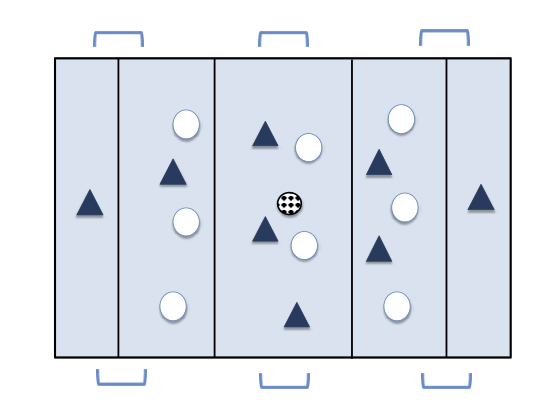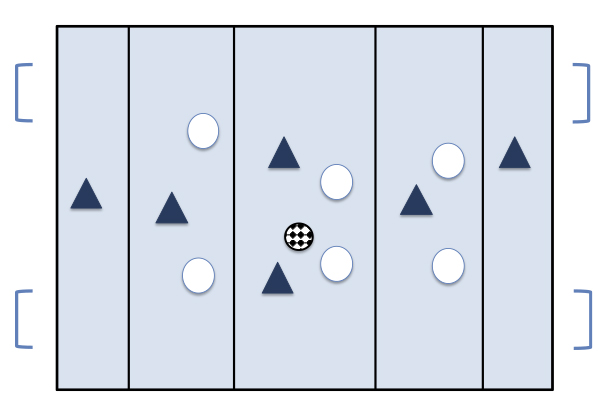Table 2
Proposed seven POS designs for the three formats studied
| N | Format* | Design: organisation and objectives | Diagram |
| 1 | 8 vs.8 (34×48) 6 vs. 6 (25×38) | Organisation: 5 areas arranged vertically with 6 mini-goals placed five metres from each touchline. Objective: possession of the ball between the areas to generate movement from one side to the other in order to clear the areas around the goals. Meanwhile, the defenders have to move based on the ball, occupying the area where the ball is and the two adjacent strips and attempt to recover it as quickly as possible. No more than one player from each team can occupy each square and goals may be scored in any of the six goals. |  |
| 2 | 8 vs. 8 (34×48) 7 vs. 7 (30×40) | Organisation: 8 squares and two 5-metre strips at the sides; a goal (with a goalkeeper) five metres from each goal line. The game begins with 1 vs. 1 in each square. Objective: possession of the ball to generate spaces between the squares. For a player to be eligible to shoot, the ball must travel from one side to the other through at least four squares. The defenders have to press, trying to recover the ball as quickly as possible. No more than one player from each team can occupy each square and goals may be scored in either goal. |  |
| 3 | 8 vs. 8 (30×32 + banda lateral de 5 metros) | Organisation: 1 square comprised of 4 triangles plus a 5-metre strip at the base of each triangle; a mini-goal five metres from each base; 4 players from each team are arranged in two opposite triangles and try to win possession of the ball between the triangles. Objective: for a player to be eligible to shoot, five passes must be made, followed by a pass between the lines to set up a player on the same team, but from the opposite triangle and coming from the sides. No more than two players from each team may occupy each triangle and goals may be scored in any of the four goals. |  |
| 4 | 8 vs. 8 (34×44) 7 vs.7 (30×40) | Organisation: 4 squares and a 5-metre strip on each of the sides; two goals (with goalkeeper) five metres from each goal line. Objective: possession of the ball with the aim of creating clear spaces between the squares to create scoring opportunities. The defenders have to press to recover the ball. Variations: for a player to be eligible to shoot, the ball must: 1. travel through at least three squares; 2. travel through all the squares; 3. travel from one side to the other. No more than two players from each team may occupy each square. Goals may be scored in either goal. |  |
| 5 | 7 vs. 7 (25×30 cada rombo) 6 vs.6 (22,5×25 cada rombo) | Organisation: double diamonds joined together forming 2 triangles in the middle; four mini-goals (five metres from one side of each diamond); 2 teams of 6 or 7 players divided equally (3-3 or 4-3). Objective: possession of the ball between the diamonds until 5 passes are made, then 1 player from the same team has to “go down” or move to the adjacent triangle to shoot with a single touch. No more than two players from each team can occupy each diamond and goals may be scored in any of the four goals. |  |
| 6 | 6 vs. 6 (25×34) | Organisation: 5 areas arranged vertically with 2 mini-goals placed five metres from each goal line. Objective: possession of the ball between the areas to reach the final zone with a through pass. The defenders have to press to recover the ball as quickly as possible. Variations: for a player to be eligible to shoot, the ball must: 1. travel through at least two areas; 2. travel through three areas, and 3. travel through four areas, reaching the end zone in each variant in order to score. Goals may be scored in any of the four goals. |  |
| 7 | 7 vs. 7 (30×46) 6 vs. 6 (26×36) | Organisation: 3 areas arranged vertically, with a 5-metre strip around the pitch; 4 goals (with goalkeeper) five metres away from each side of the pitch. Objective: possession of the ball between the areas with the aim of reaching the aforementioned strip with a through pass. The defenders have to press to recover the ball. Variations: for a player to be eligible to shoot, the ball must: 1. travel through at least two areas; 2. travel through all three areas, and 3. move from one side to the other. Goals may be scored in any of the four goals. |  |
| * In brackets, the width and length of the pitch used in each design (in meters). | |||


